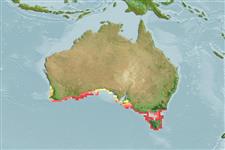>
Perciformes/Notothenioidei (Icefishes) >
Bovichtidae (Thornfishes)
Etymology: Halaphritis: Greek, als = salt + Greek, aphritis, -idos = anchovy (Ref. 45335); platycephala: Named for its flat head..
More on authors: Last, Balushkin & Hutchins.
Environment: milieu / climate zone / depth range / distribution range
Ökologie
seewasser demersal; tiefenbereich 5 - 13 m (Ref. 43123). Temperate
Eastern Indian Ocean: Tasmania, Australia.
Size / Gewicht / Alter
Maturity: Lm ? range ? - ? cm
Max length : 16.8 cm SL Männchen/unbestimmt; (Ref. 43123)
Kurzbeschreibung
Morphologie | Morphometrie
Rückenflossenstacheln (insgesamt): 9; Rückenflossenweichstrahlen (insgesamt): 24-25; Afterflossenstacheln 0; Afterflossenweichstrahlen: 22 - 23; Wirbelzahl: 43
Lives deep inside caves or under ledges in semi-exposed habitats in the near shore where light levels are low. Adapted to creeping around the bottom in cramped confines. In captivity, it crawls over the substrate rather than swim. Feeds on shrimps and other small crustaceans in captivity (Ref. 43123).
Life cycle and mating behavior
Geschlechtsreife | Fortpflanzung | Ablaichen | Eier | Fecundity | Larven
Last, P.R., A.V. Balushkin and J.B. Hutchins, 2002. Halaphritis platycephala (Notothenioidei: Bovichtidae): a new genus and species of temperate icefish from southeastern Australia. Copeia 2002(2):433-440. (Ref. 43123)
IUCN Rote Liste Status (Ref. 130435)
Bedrohung für Menschen
Harmless
Nutzung durch Menschen
Mehr Information
NamenSynonymeMetabolismusRäuberÖkotoxikologieFortpflanzungGeschlechtsreifeAblaichenSpawning aggregationFecundityEierEientwicklung
Alter/GrößeWachstumLänge-GewichtLänge-LängeLängenhäufigkeitenMorphometrieMorphologieLarvenLarven Pop.Dyn.RekrutierungDichteBRUVS
ReferenzenAquakulturAquakultur ProfilZuchtlinienGenetikElectrophoresesVererbbarkeitKrankheitenVerarbeitungNutrientsMass conversion
PartnerBilderStamps, Coins Misc.LauteCiguateraGeschwindigkeitSchwimmstilKiemenoberflächeOtolithsGehirngrößeSehfähigkeit
Tools
Zusatzinformationen
Download XML
Internet Quellen
Estimates based on models
Preferred temperature (Ref.
123201): 13.4 - 18.3, mean 17 °C (based on 75 cells).
Phylogenetic diversity index (Ref.
82804): PD
50 = 1.0005 [Uniqueness, from 0.5 = low to 2.0 = high].
Bayesian length-weight: a=0.00427 (0.00162 - 0.01121), b=3.16 (2.93 - 3.39), in cm total length, based on LWR estimates for this (Sub)family-body shape (Ref.
93245).
Trophic level (Ref.
69278): 3.6 ±0.55 se; based on food items.
Widerstandsfähigkeit (Ref.
120179): hoch, Verdopplung der Population dauert weniger als 15 Monate. (Preliminary K or Fecundity.).
Fishing Vulnerability (Ref.
59153): Low vulnerability (11 of 100).
